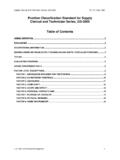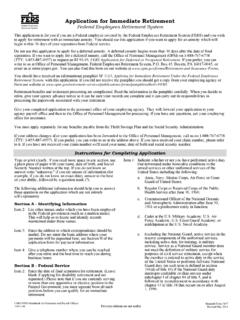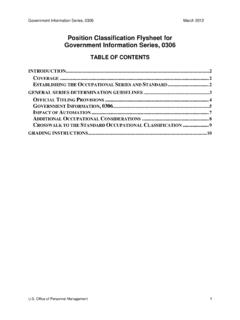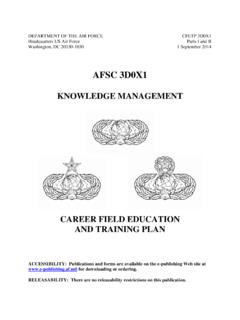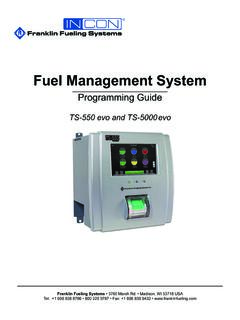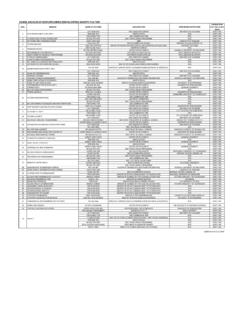Transcription of Position Classification Flysheet for Computer …
1 Computer Science Series, GS-1550 TS-83 January 1988 Position Classification Flysheet for Computer Science Series, GS-1550 Table of Contents SERIES OCCUPATIONAL AUTHORIZED GRADE LEVEL Office of Personnel Management 1 Computer Science Series, GS-1550 TS-83 January 1988 SERIES DEFINITION This series includes professional positions which primarily involve the application of, or research into, Computer science methods and techniques to store, manipulate, transform or present information by means of Computer systems. The primary requirements of the work are (a) professional competence in applying the theoretical foundations of Computer science, including Computer system architecture and system software organization, the representation and transformation of information structures, and the theoretical models for such representations and transformations; (b) specialized knowledge of the design characteristics, limitations, and potential applications of systems having the ability to transform information, and of broad areas of applications of computing which have common structures, processes, and techniques.
2 And (c) knowledge of relevant mathematical and statistical sciences . This revised series-coverage standard supersedes the series-coverage standard published for this series in June 1977. The series has been expanded to include application of advanced techniques in Computer science as well as the research and development work covered by the previous standard. OCCUPATIONAL INFORMATION Computer scientists in the Federal service develop new and improved concepts, principles, and techniques that will advance the body of knowledge of Computer science, and adapt and apply advanced Computer science methods and techniques to solve complex Computer processing requirements.
3 Terms and definitions common to this occupation can be found in the American National Dictionary for Information Processing Systems published by the Computer and Business Equipment Manufacturers Association, Washington, , and in the Glossary of Terms contained in the Job Family Position Classification Standard for Administrative Work in the Information Technology Group, GS-2200. Typical functions performed by Computer Scientists include: -- Development of software systems using a knowledge of techniques, procedures, and processes such as operating system theory, data structures, Computer system architecture, Software engineering, and Computer communications.
4 -- Development of Computer graphics systems using a knowledge of graphic display systems, general purpose graphics languages, and optimization techniques involving preprocessors graphical algorithms, memory management methods, and high-speed communication links. -- Development of high-speed computing systems and real time data acquisition systems using a knowledge of: Office of Personnel Management 2 Computer Science Series, GS-1550 TS-83 January 1988 (1) models of computation, performance measures, and systems architecture types and levels of representation; (2) fast algorithms and their performance and relationship to system architecture; (3) architecture of high-speed systems, interconnection structures, centralized and distributed control, data-driven architectures, and parallel programming languages.
5 -- Development of integrated Computer systems using a knowledge of: (1) Computer software concepts such as data representation, data structures, file systems, operating systems, Computer languages, software development methodologies, and network protocols; (2) Computer hardware concepts such as Computer architecture, Computer communication systems, peripheral control systems, and bus architectures; and (3) mathematics such as calculus, mathematical analysis, probability, linear algebra, statistics, discrete structures, and abstract algebra. -- Research in artificial intelligence including the application of computers to solve problems and to understand the principles of human intelligence.
6 -- Investigation of discrete speech recognition by development of a word recognition study model. -- Development of problem-oriented and nonprocedural languages and their translating/operating systems, construction of input-output buffering schemes, and design of automatic scheduling and monitoring methods to increase scope and effectiveness of Computer applications. -- Development of advanced concepts of automation and information processing display, control, and transfer. -- Research in computational complexity and the analysis of algorithms to explore data structures that lead to highly efficient combinatorial algorithms.
7 -- Development of an abstract complexity theory to provide a theoretical foundation for understanding the properties of the running times of efficient Computer programs for a given function. -- Investigation into the mathematical structure of deterministic context free languages. -- Research study to gain a deeper understanding of how to measure computational complexity and how to compare computational power of different Computer models. Office of Personnel Management 3 Computer Science Series, GS-1550 TS-83 January 1988 -- Development of different cost methods to provide a clearer understanding of the behavior of many algebraic algorithms with particular emphasis on the appropriate notion of sparsity for a given problem.
8 EXCLUSIONS Duties of Computer science positions may overlap with closely related series such as the Computer Engineering Series, GS-0854, the Mathematics Series, GS-1520, and the Job Family Position Classification Standard for Administrative Work in the Information Technology Group, GS-2200. A Position is included in the Computer Science Series when professional Computer science knowledge is the paramount requirement for performing the duties of the Position ; the basis for the required application of this knowledge should be reflected in the Classification factors. Some positions having duties that meet the Computer Science series definition may be interdisciplinary with and classifiable to other professional series such as those for the excluded positions discussed below.
9 Interdisciplinary procedures for professional positions are discussed in the Introduction to the Position - Classification Standards and may be used at the discretion of the agency. The following types of positions illustrate those which are excluded from the Computer Science Series because of the nature of the paramount qualification requirements and the primary emphasis of the work: 1. Positions involving work requiring primarily knowledge of the fundamentals and principles of professional engineering for the research, design, development, test, and evaluation of Computer hardware and software in an integrated manner, are classified in the Computer Engineering Series, GS-0854.
10 Computer scientists and Computer engineers may both design complex software systems. Computer engineers apply professional engineering knowledge of Computer hardware and provide a balanced hardware I software engineering expertise; Computer scientists apply an in-depth knowledge of Computer theory, algorithms, data structures, programming concepts and languages, and Computer architecture, with a working knowledge of Computer hardware capabilities. 2. Positions involving work requiring primarily knowledge of the principles, techniques, and practices of electronics engineering, pertaining to electronic circuits, circuit elements, equipment, systems, and associated phenomena, are classified in the Electronics Engineering Series, GS-0855.




